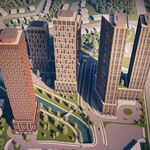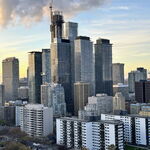I believe this was one of the new train sets.
View attachment 592987
View attachment 592988
Their article didn't say what the train number was or what date the incident occured but I found it in the logs, it was train 622 eastbound from Montreal to Quebec on the 31st of Aug (yesterday).
https://asm.transitdocs.com/train/2024/08/31/V/622
Based on the GPS trace from the link above, here's the timeline of what happened. This all occurred between Drummondville and Québec Ste-Foy on the single-tracked CN Drummondville Subdivision. The weather was 18 degrees with light drizzle, 100% humidity, visibility 2 km. Winds were less than 5 km/h.
At 11:04 they stopped the train near Milepost 24, located 1.7 km west of the town of Saint-Janvier-de-Joly. Three minutes earlier the train had been going 129 km/h so this was presumably an immediate braking application, not an attempt to coast to the nearest town or crossing. It would remain there for about 2.5 hours.
At 13:43 the train started moving again, remaining below 50 km/h (30 mph). It travelled another 12.6 km, travelling slowly throuth the town of Laurier-Station where it passed Via 37 (westbound to Ottawa via Montreal) which was waiting for it in the siding there. Via 37 departed the siding at 14:02 and continued normally, arriving in Montreal 44 minutes late, and Ottawa 35 minutes late.
Train 622 became stranded at 14:03, coming to a stop near Milepost 25, located 6.8 km east of Laurier-Station and 5.6 km west of St-Apolinnaire. It would remain there for the next 4 hours. The site where the train was stranded is immediately adjacent to Chemin Bourret (a public road), adjacent to Exit 285 Rang de Pierriche on Autoroute 20. It's a 2h15 drive from Via's headquarters in downtown Montréal, or a 1h drive from Québec gare du Palais. This is a single-tracked segment so the train was blocking all rail traffic between Montreal and Quebec.
At 15:25 Via 24, the next eastbound train from Montreal to Quebec (originating in Ottawa), pulled up behind train 622. At some point in the next 3 hours, they coupled the two trains together.
At 18:13 the two trains started heading slowly back to the siding in Laurier-Station. At 18:19 they stopped for about 15 min within the siding near its east end. At 18:35 they started moving slowly to the west end of the siding (near the centre of the town), arriving there at 18:43. The GPS trace for train 622 ends at 18:49, though there is a single ping at 21:04 immediately west of the siding.
According to the
CityNews article, firefighters helped evacuate Via 622 and transfer them to Via 24. There were not enough seats for the combined passenger loads within the single train, so many passengers needed to stand.
At 20:36, Via 24 departed eastbound to Quebec. It travelled slowly within the siding and then accelerated to the 90 mph speed limit (145 km/h), travelling at normal track speeds for the remainder of the journey to Québec Gare du Palais, arriving there at 21:54, which is 5h43 late compared to its schedule, or 10h06 late compared to the schedule of Via 622.
Here is an overview of the various places the train stopped:








